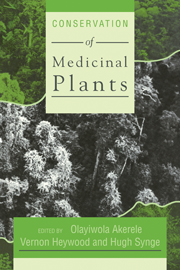Book contents
- Frontmatter
- Contents
- Contributors
- Preface
- Acknowledgements
- The Chiang Mai Declaration
- Introduction
- The Issue of Medicinal Plants
- Science, Industry and Medicinal Plants
- Techniques to Conserve Medicinal Plants
- 10 Agronomy Applied to Medicinal Plant Conservation
- 11 Biotechnology in the Production and Conservation of Medicinal Plants
- 12 Enhancing the Role of Protected Areas in Conserving Medicinal Plants
- 13 Botanic Gardens and the Conservation of Medicinal Plants
- 14 The Role of Chinese Botanical Gardens in Conservation of Medicinal Plants
- Policies to Conserve Medicinal Plants
- Experiences from Programmes to Conserve Medicinal Plants
13 - Botanic Gardens and the Conservation of Medicinal Plants
Published online by Cambridge University Press: 07 September 2010
- Frontmatter
- Contents
- Contributors
- Preface
- Acknowledgements
- The Chiang Mai Declaration
- Introduction
- The Issue of Medicinal Plants
- Science, Industry and Medicinal Plants
- Techniques to Conserve Medicinal Plants
- 10 Agronomy Applied to Medicinal Plant Conservation
- 11 Biotechnology in the Production and Conservation of Medicinal Plants
- 12 Enhancing the Role of Protected Areas in Conserving Medicinal Plants
- 13 Botanic Gardens and the Conservation of Medicinal Plants
- 14 The Role of Chinese Botanical Gardens in Conservation of Medicinal Plants
- Policies to Conserve Medicinal Plants
- Experiences from Programmes to Conserve Medicinal Plants
Summary
Introduction
Botanic gardens in the western tradition have been intimately involved in the cultivation of medicinal herbs since their earliest beginnings. In fact, the first botanic gardens were medicinal or herbal gardens, attached to faculties or schools of medicine and created for the provision of medicinal plants for study by students and for the actual production of drugs. Such were the 16th century Italian botanic gardens of Pisa, Padova and Florence, the latter still called today the Giardino dei Semplice (Garden of Simples), and in other countries of western Europe (Garbari & Raimondo, 1986; Heywood, 1987; Stafleu, 1969).
These early physic or medicinal gardens are a reminder of the very close relationships that existed between botany, pharmacy and medicine in earlier times. In fact they could not be easily separated. This link between botany and medicine persisted until the 20th century with medical students in British universities attending lectures in botany in their first year of studies; and even today there are Departments of Botany in Faculties of Pharmacy as well as Science in Spanish, French and Portuguese universities.
Many of these 16th and 17th century botanic gardens were very small and in urban settings. Today, they are often at risk of closure and regarded by many as little more than living museums although some of them have made great efforts to modernize and widen their facilities.
The medicinal role of some botanic gardens was sometimes directed to the exterior as in the case of Nantes where the botanic garden was originally in the 18th century the Jardin des Apothicaires, which grew medicinal plants for the medicine chests of the doctors of ships sailing from the port.
- Type
- Chapter
- Information
- Conservation of Medicinal Plants , pp. 213 - 228Publisher: Cambridge University PressPrint publication year: 1991
- 8
- Cited by



